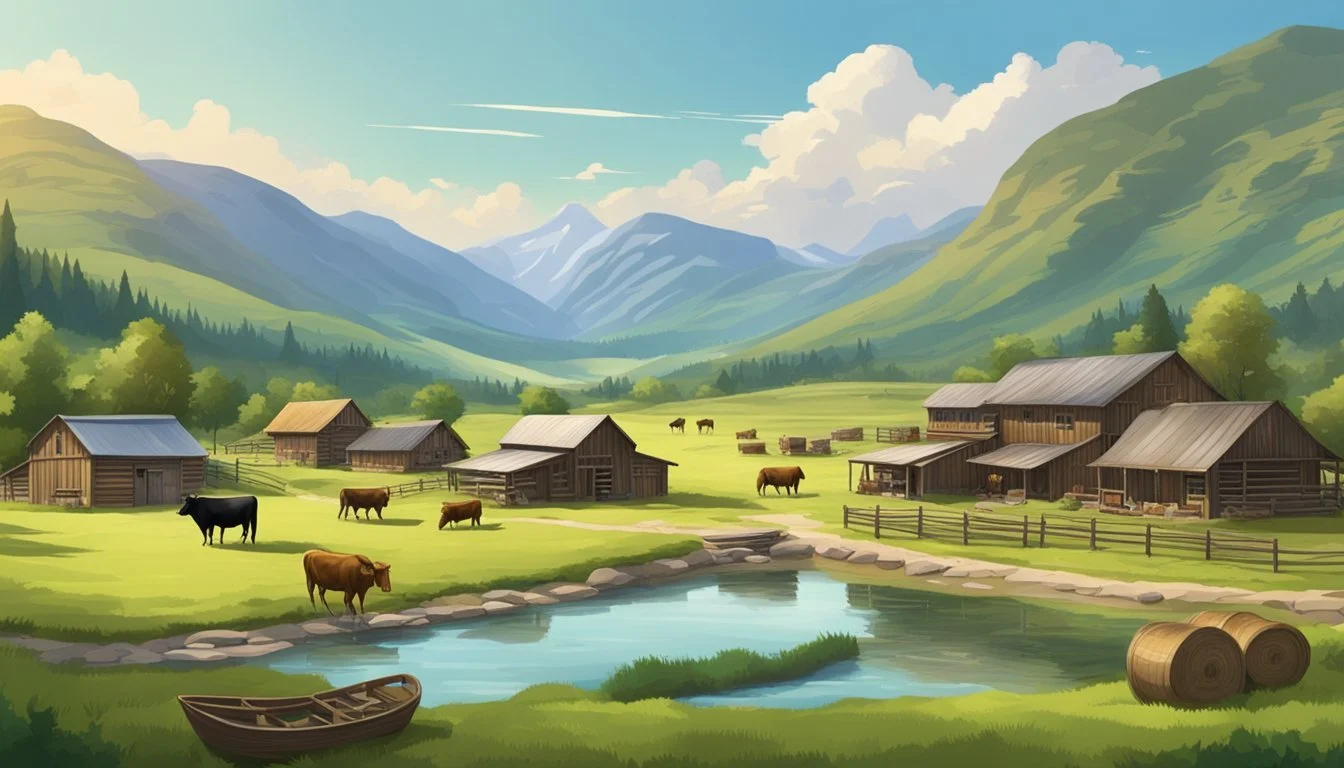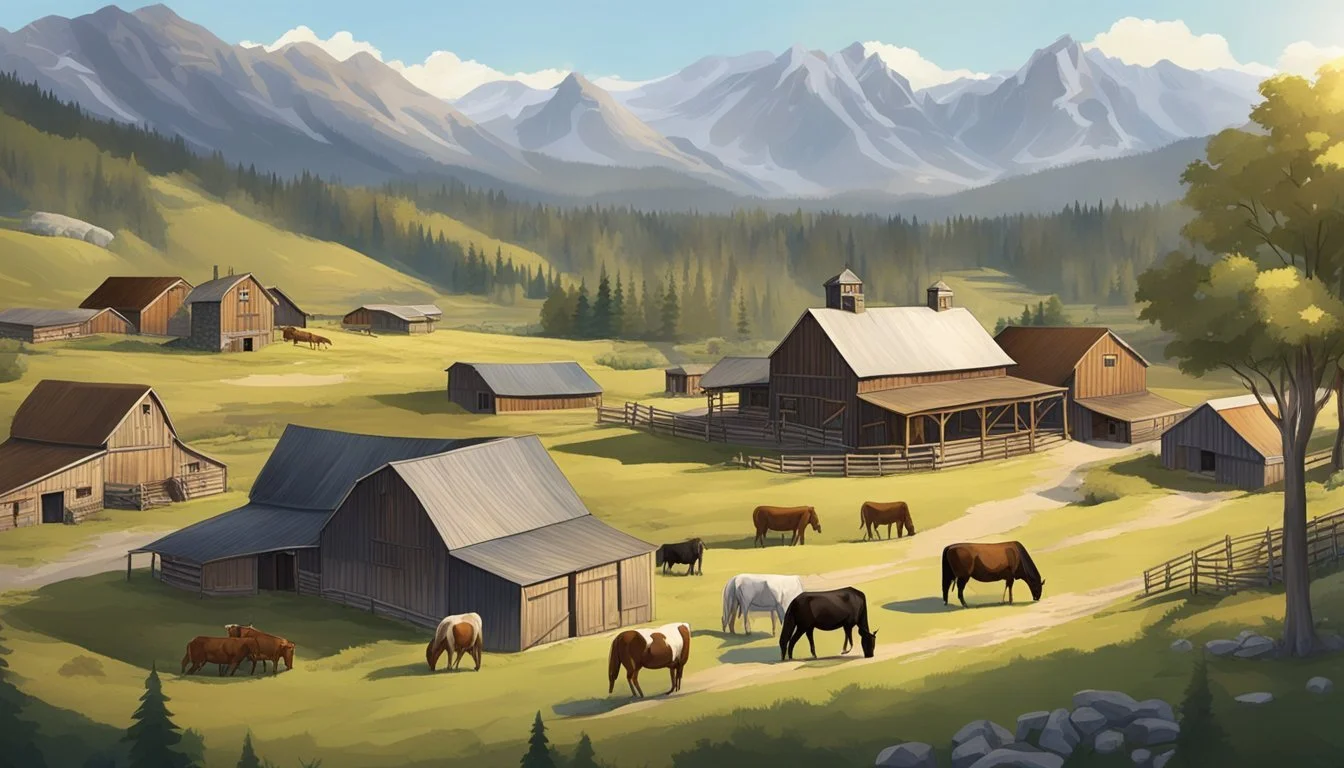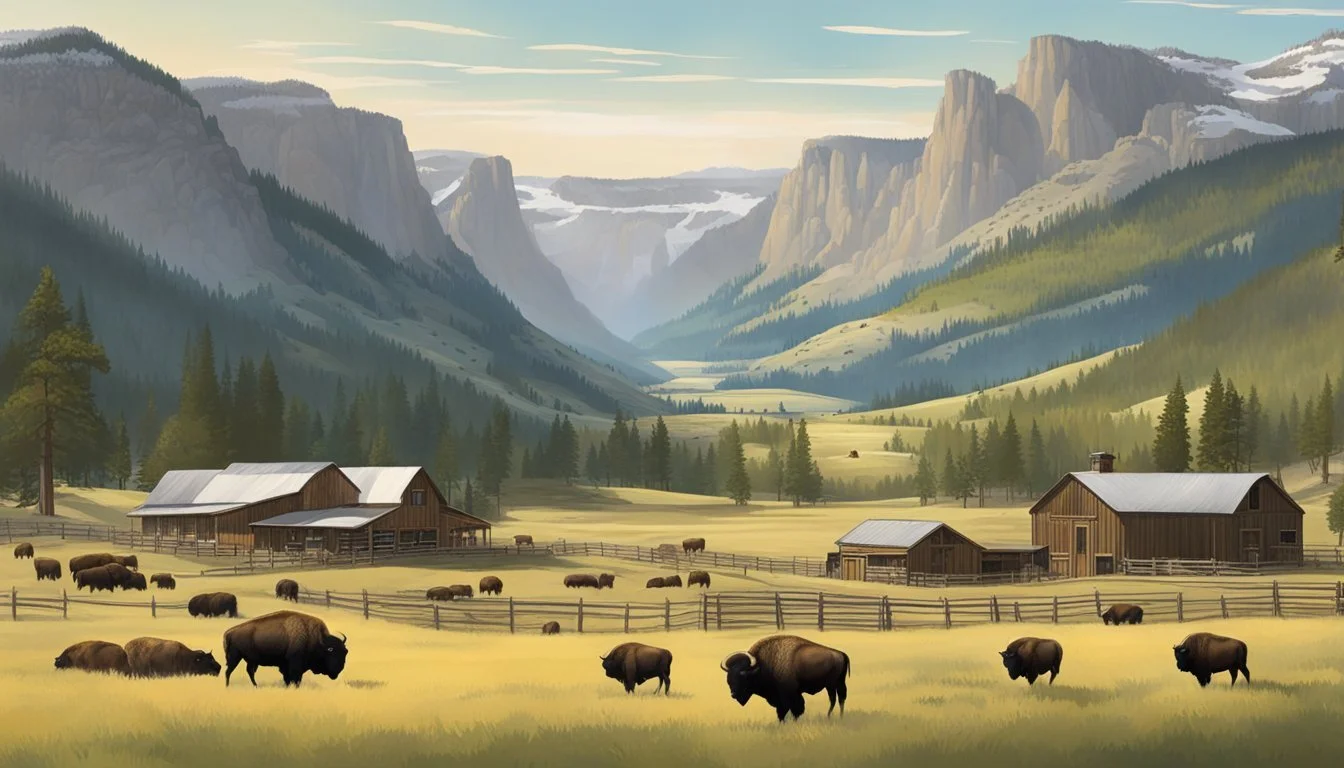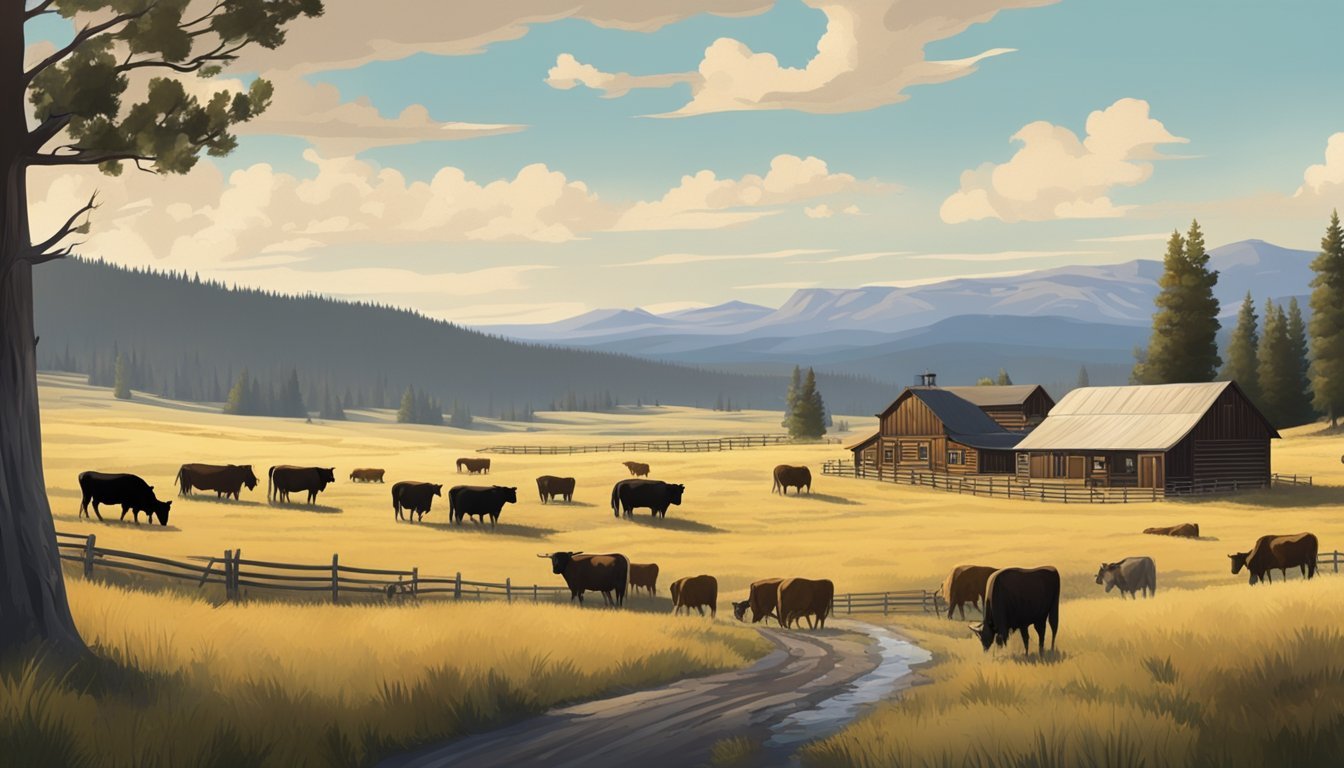The Real-Life Inspirations Behind Yellowstone's Dutton Ranch
Montana's Historic Cattle Empires
Yellowstone, the hit Paramount Network series created by Taylor Sheridan, has captivated audiences with its portrayal of the powerful Dutton family and their sprawling Montana ranch. While the Dutton family and their Yellowstone Ranch are fictional creations, they draw inspiration from real-life ranches and the rich history of the American West.
The series, starring Kevin Costner as patriarch John Dutton, is filmed on a working cattle ranch in Montana called the Chief Joseph Ranch. This 150-acre property near Darby, Montana has been in operation since 1880 and serves as the real-life backdrop for the fictional Dutton family home. The picturesque setting, with its vast landscapes and rugged terrain, provides an authentic backdrop for the show's dramatic storylines.
Yellowstone's themes of land ownership, family legacy, and conflicts with developers and Indigenous interests reflect real challenges faced by ranchers in the modern American West. Taylor Sheridan's storytelling draws on these elements to create a compelling narrative that resonates with viewers while showcasing the beauty and complexity of ranch life in Montana.
Historical Context
The Dutton Ranch in "Yellowstone" draws inspiration from real-life ranching history and Native American conflicts in the American West. These elements shape the show's narrative and characters.
American Western Lifestyle and the Dutton Family
The Dutton family embodies the quintessential American Western lifestyle. Ranching has been a cornerstone of Western culture since the 19th century. Large cattle operations, like the fictional Dutton Ranch, played a crucial role in shaping the economic and social landscape of states like Montana.
John Dutton, the family patriarch, represents the traditional rancher archetype. His children, including Beth and Lee, grapple with maintaining their Western heritage in a changing world. The show explores the challenges faced by modern ranching families, including land disputes and economic pressures.
The Nez Perce War and Its Influence
The Chief Joseph Ranch, where "Yellowstone" is filmed, holds historical significance tied to the Nez Perce War of 1877. This conflict between the U.S. government and the Nez Perce tribe led by Chief Joseph left a lasting impact on the region.
The war resulted from attempts to force the Nez Perce onto reservations. Chief Joseph's strategic leadership during the conflict earned him recognition. The ranch's name honors this history, connecting the show's setting to real events that shaped the American West.
This historical backdrop adds depth to the series, highlighting ongoing tensions between ranchers, Native Americans, and government entities in the region.
Geographical Significance
The Dutton Ranch's location in Montana's Bitterroot Valley provides a stunning backdrop that captures the essence of the American West. Its proximity to Yellowstone National Park further enhances its geographical importance.
Montana's Bitterroot Valley
The Dutton Ranch, filmed at the Chief Joseph Ranch near Darby, Montana, sits in the picturesque Bitterroot Valley. This location embodies quintessential Montana scenery, with its sweeping grasslands, rugged mountains, and pristine rivers. The valley's natural beauty and rich ranching history make it an ideal setting for the show's themes of land preservation and family legacy.
The Bitterroot Valley's diverse landscape allows for a variety of filming locations, from lush forests to open plains. This geographical diversity mirrors the complex storylines and characters in "Yellowstone."
Comparison to Yellowstone National Park
While the Dutton Ranch is not located within Yellowstone National Park, its proximity adds depth to the show's narrative. The park's iconic status as a symbol of wilderness conservation aligns with the Dutton family's struggle to protect their land.
Yellowstone National Park's geothermal features, diverse wildlife, and vast wilderness serve as a constant reminder of the natural world's power and beauty. This comparison highlights the delicate balance between human development and nature preservation, a central theme in the series.
The show often references the park, drawing parallels between its protected status and the Duttons' efforts to maintain their ranch's integrity against external pressures.
The Iconic Chief Joseph Ranch
The Chief Joseph Ranch in Darby, Montana serves as the real-life backdrop for the fictional Dutton Ranch in Yellowstone. This working cattle ranch boasts a rich history and stunning architecture that perfectly embodies the show's rugged Western aesthetic.
History of the Ford-Hollister Lodge
The ranch's centerpiece, now known as the Dutton family home, was originally built in 1914 as the Ford-Hollister Lodge. William S. Ford and Howard Clark Hollister, glass tycoons from Dayton, Ohio, commissioned the 6,000-square-foot lodge. They envisioned it as a summer retreat.
The lodge's construction utilized local materials, including logs and stones from the property. This attention to detail preserved the area's natural beauty and created a timeless architectural masterpiece.
Over the years, the ranch changed hands several times. It was eventually named after Chief Joseph of the Nez Perce tribe, who led his people through the Bitterroot Valley during their famous flight to Canada in 1877.
Ranch As Set for the Dutton Family Home
Yellowstone's production team chose the Chief Joseph Ranch as the ideal setting for the Dutton family's sprawling homestead. The ranch's 2,500 acres provide a picturesque backdrop for the show's dramatic storylines.
The lodge's rustic elegance and expansive views of Montana's Bitterroot Valley align perfectly with the Dutton family's powerful ranching dynasty. Filmmakers use both the exterior and interior of the main house for shooting scenes.
Two guest cabins on the property, the Fisherman Cabin and Ben Cook Cabin, also feature prominently in the series. These structures add authenticity to the ranch's portrayal as a working cattle operation.
Architectural Elements and Set Design
The Yellowstone Ranch's architecture and set design blend rustic charm with functional elegance. Authentic materials and period-appropriate details create an immersive Western atmosphere.
Cabins and Bunkhouse Design
The cabins and bunkhouse on Yellowstone's Dutton Ranch showcase classic Western architectural elements. Rough-hewn timber frames and stone foundations give the structures a rugged, timeless appeal. Wide porches provide shaded outdoor living spaces, perfect for taking in sweeping Montana vistas.
Inside, exposed wooden beams and stone fireplaces create a cozy, lived-in feel. The set designers incorporate authentic period furnishings and decor to enhance the historical accuracy. Weathered leather chairs, Native American textiles, and antique ranch equipment add layers of authenticity.
The bunkhouse features an open floor plan with a communal living area and simple bunk beds. This layout reflects the practical needs of ranch hands while fostering a sense of camaraderie. Vintage saddles, ropes, and other cowboy gear adorn the walls, emphasizing the working nature of the space.
Cultural Impact
Yellowstone has left an indelible mark on American popular culture, sparking renewed interest in the Western genre and ranch life. The show's influence extends far beyond television, shaping fashion trends and travel destinations.
Influence on Modern American Culture
Yellowstone has reignited fascination with the American West. The series popularized Western-inspired fashion, with cowboy hats, boots, and denim becoming trendy even in urban areas. Retail chains reported increased sales of Western wear following the show's success.
The Dutton lifestyle has inspired a wave of ranch tourism. Many viewers seek to experience the rugged beauty of Montana firsthand. Local businesses near filming locations have seen a surge in visitors eager to explore "Yellowstone Country."
Taylor Sheridan's portrayal of modern ranching challenges has also raised awareness about land conservation issues and conflicts between ranchers and developers.
Yellowstone's Fandom and Media Presence
Yellowstone boasts a dedicated fanbase that engages passionately with the show online. Fan theories, episode discussions, and character debates dominate social media platforms during each season.
The series has spawned numerous podcasts, fan sites, and YouTube channels dedicated to analyzing plot points and character arcs. Paramount Network capitalized on this enthusiasm with official merchandise and immersive fan experiences.
Kevin Costner's portrayal of John Dutton has cemented his status as a cultural icon. The actor's involvement helped attract a diverse audience, bridging generational gaps in viewership.
Behind the Scenes
The Yellowstone series brings the rugged world of Montana ranching to life through meticulous attention to detail and authentic performances. From stunning on-location filming to the cast's immersion in cowboy culture, the show's production creates a vivid and believable portrayal of the modern American West.
Filming and Production Experience
Yellowstone's primary filming location is the Chief Joseph Ranch in Darby, Montana. This working cattle ranch serves as the iconic Dutton Ranch seen in the show. The production utilizes various buildings on the property, including the Fisherman Cabin and Ben Cook Cabin, which appear as guest accommodations in the series.
Taylor Sheridan, the show's creator, chose this location for its breathtaking scenery and authentic ranch atmosphere. The production team works closely with local experts to ensure accuracy in depicting ranch life. Additional filming takes place on a 40,000-square-foot soundstage in Missoula and on the Crow Indian Reservation near Billings.
The Real Cowboys: Cast and Characters
The cast of Yellowstone undergoes extensive training to portray convincing ranch hands and cowboys. Kevin Costner, who plays John Dutton, brings his wealth of Western film experience to the role. Cole Hauser, portraying the fan-favorite character Rip Wheeler, spent months learning to ride and rope like a real cowboy.
Many of the show's background actors are actual ranchers and cowboys, adding authenticity to crowd scenes. The costume department works meticulously to ensure that each character's wardrobe reflects their role on the ranch and personal style.
Cast members often speak about the transformative experience of working on the show, with many developing genuine horse-riding and ranching skills. This dedication to realism helps create the immersive world that has captivated millions of viewers.
Comparative Analysis
The Dutton Ranch in Yellowstone shares similarities with real-life iconic ranches while maintaining its fictional elements. This analysis explores how the show's portrayal compares to actual ranches and examines the blend of fact and fiction in Western dramas.
Other Ranches and Their Stories
The King Ranch in Texas spans 825,000 acres, dwarfing Yellowstone's fictional Dutton Ranch. Founded in 1853, it pioneered cattle breeding techniques and influenced ranching practices nationwide.
The 6666 Ranch, featured in Yellowstone's spin-off, covers 266,000 acres in Texas. It's renowned for its quarter horse breeding program and oil production, mirroring the Dutton Ranch's diversified operations.
Shelton Ranch in Montana, though smaller, exemplifies the challenges faced by family-owned ranches. Its struggles with preservation and modernization echo themes explored in Yellowstone.
Fiction vs. Reality in Western Dramas
Yellowstone amplifies real ranch conflicts for dramatic effect. Land disputes, family feuds, and political battles are common, but the show intensifies these elements.
Actual ranches face less frequent violence and legal battles than depicted in the series. However, the show accurately portrays the passion ranchers have for their land and lifestyle.
Environmental challenges and economic pressures on ranches are realistically portrayed. The show's depiction of the clash between tradition and progress reflects genuine concerns in the ranching community.
Yellowstone's portrayal of Native American issues draws from real conflicts but simplifies complex historical and cultural dynamics for narrative purposes.
Current State and Legacy
The Dutton Ranch depicted in "Yellowstone" continues to capture viewers' imaginations while drawing attention to real-world issues facing modern ranchers. Its portrayal reflects ongoing tensions between preservation and development in the American West.
Preservation of the Ranch and Landscape
The Chief Joseph Ranch, which serves as the filming location for the fictional Dutton Ranch, remains a working cattle operation. Its owners balance their ranching lifestyle with hosting film crews and preserving the property's historic buildings. This mirrors challenges faced by many real ranches striving to maintain their land and traditions.
The ranch's proximity to ancestral lands of the Nez Perce and Salish tribes highlights complex histories of land use in the region. Some Native American groups work to reclaim territories and preserve cultural connections to the landscape.
Conservation efforts in Montana aim to protect open spaces and wildlife corridors near properties like the Chief Joseph Ranch. These initiatives often involve partnerships between ranchers, environmental groups, and government agencies.
Exploring the Dutton Ranch in Person
The Dutton Ranch from Yellowstone can be visited in real life. Fans can experience the filming locations and breathtaking Montana landscapes that bring the show to life.
Tourism and Visitor Experiences
The real-life Dutton Ranch is actually Chief Joseph Ranch in Darby, Montana. This working cattle ranch opens its doors to visitors during certain times of the year. Guided tours allow fans to see iconic locations from the show.
Guests can explore the historic lodge and barns built in the early 1900s. These structures serve as key backdrops in Yellowstone. The property offers stunning views of the Bitterroot Mountains.
Nearby Yellowstone National Park provides additional opportunities to immerse oneself in the natural beauty showcased in the series. Visitors can spot wildlife, hike trails, and witness geothermal features.
Some local tour companies offer Yellowstone-themed excursions. These trips take fans to filming locations around Montana, including the ranch exteriors. Participants can recreate scenes and learn behind-the-scenes details about the show's production.








